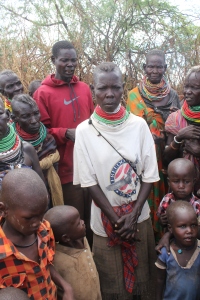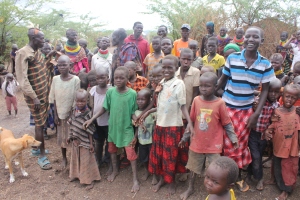Kenya’s Meteorological Department has raised alarm over the persistent drought while the government urges the pastoralists to sell their animals to the Kenya Meat Commission (KMC).
Turkana county, geographically situated in the semi-arid region, is categorized as Arid and Semi-Arid Lands (ASAL). For over a year now it has been experiencing a calamitous drought causing suffering to thousands of victims, both local Turkana people and the refugees who are taken care of by UNHCR at the second largest refugee camp of Kakuma. The thousands of refugees have also been affected by the cut in food rations since the fall of 2013.
The Turkana who live a nomadic way of life with their animals had earlier made agreement with the administration of neighboring Uganda to cross with their animals to look for greener pasture and water. However, the pastoralists had previously faced attacks by bandits from the neighboring borders of Ethiopia, South Sudan and Uganda which led to an agreement being made in December between Kenyan and Ugandan administrators at the border town of Loima for the benefit of pastoral communities living along the border.
Consequently, the Turkana governor, Josphat Nanok and other leaders have appealed to both the government and humanitarian agencies to intervene and supply relief food to the affected victims. “We are asking humanitarian support to save the lives of the thousands who are displaced and living in hunger,” said Josphat Nanok.

The Turkana Central Administrator said in Lodwar town that the government will bring relief supplies. This was evidenced when some trucks ferrying relief supplies flagged off to Turkana in early February according to information from the office of the Devolution Secretary Anne Waiguru, in whose docket Disaster Management falls. Ms. Waiguru and her counterpart in the Ministry of Agriculture, Felix Kosgey made comments on the issue of disaster at different press conferences. However, the entire issue has become a blame on the National government.
It is an unfolding National Human Disaster where a Turkana woman was reported to have served a meal of dog to sustain her family from hunger for an extra day. On Saturday 25th January, two children reportedly died at Lodwar District Hospital due to severe malnutrition; and many other children have been admitted to the hospital over the months. In an interview with Kenya Daily Post, the Turkana Country Nutrition Officer, Alice Jelimo, said that several patients suffering from malnutrition have been admitted to the same hospital since December last year.

Additionally, Jelimo explained that most areas within Turkana County have had long drought for several months and the short usual rains failed leading to lack of water for animals and humans where the elderly members of the community have been forced to eat dog meat due to hunger.
In February, Kanere reporters approached Turkana Sub-County officials, however the concerned officials at the county did not wanted to have their names mentioned regarding what they termed as a serious human error. “I cannot officially speak with the press, this is a total embarrassment for the country,” an official stated on the phone.
The government through its Devolution Secretary, Anne Waiguru, stated all ASAL to be in serious trouble. Close to half the population are suffering and dying of famine in different parts of Northern Kenya. However, the government has moved sluggishly in tackling the human disaster in those Arid and Semi-Arid Lands. Government’s best advice to pastoralists was to sell their livestock to the Kenya Meat Commission.
Instead, the government should come up with a lasting solution to food security and production. Such disasters are frequently repeated, always termed as a ‘natural calamity’. Kenya’s Agriculture and Devolution Ministry leaders and other stakeholders should study the approach in other developing countries and adopt the system. While 2014 is a Global Agriculture year, the country is still lagging behind in monitoring famine disaster and atrocities coming with the calamity. The big question still remains unanswered: why do Kenyans continue to die because of famine or lack of food?
